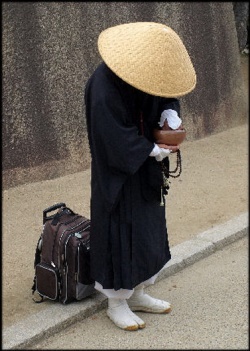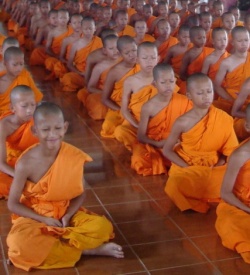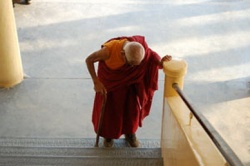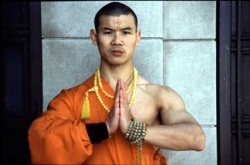Manual of Vinaya - Reading Nine: Description of the Lesser Capacity
The following reading consists of the second major section of the Song of My Spiritual Life (Nyam mgur) of Je Tsongkapa (1357-1419).
This text is also known as The Short Book on the Steps of the Path (Lam-rim bsdus-don).
Accompanying the verses of Je Tsongkapa’s root text is a commentary called Illumination of the Essence (Snying-po mdor-bsdus gsal-ba), composed by Choney Lama Drakpa Shedrup (1675-1748).
THE ACTUAL BODY OF THE TEXT
Those points concerning the offering of praise and so on are secondary parts of the text. Here I am going to make my explanation with reference to the actual meaning of the text. I shall do so in two parts: the way to practice the shared paths, and the way to practice the path which is not shared.
THE WAY TO PRACTICE THE SHARED PATHS
The discussion of the way to practice the shared paths is divided into two: the preliminary step followed by the main steps.
THE PRELIMINARY STEP
The preliminary step is covered in these lines of the root text:
(11)
After having done this, see that
the very foundation
Of an excellent start for all the good
Is the holy Spiritual Guide
who teaches you the path.
Make efforts to rely on Him properly
in your thoughts and in your actions;
Please Him with the offering of
carrying out His every instruction.
And never give it up, not even
at the cost of your life.
lived my life this way;
You, who seek for freedom,
must try to do the same.
First you must contemplate the points above, such as the great benefits that come from putting into practice all, or even just a part of, the steps of the path. After having done this, says Je Tsongkapa, you should begin the actual practices which are to follow. He uses these words to lead the reader into the actual steps of the path.
Having understood these benefits, you must then see that the holy Spiritual Guide who teaches you the path is the very foundation for getting you off to an excellent start for all the good in this and your future lives. Realize that all this depends on how you serve your Lama, and then with fierce efforts rely on Him in your thoughts by stopping that state of mind which thinks it sees faults in Him, and by developing feelings of faith towards Him as much as you can. Rely properly on your Lama in your actions by paying Him respect with your body, praising Him with your words, and so forth. Undertake whatever you can to please your Lama in every possible way, and never undertake anything which would displease Him. Accomplish whatever He or She tells you to do.
Understanding this, you must please your Lama with the offering of carrying out His every instruction. You can never give this up even at the cost of you life, so what need is there to say anything about mere small incidents? After these instructions come a special refrain, beginning with the words “I, the master meditator…” These are the actual lines as Je Tsongkapa first wrote them. Later on they were changed by someone else, and in modern prayer books we see the following:
The venerable Lamas of the past
lived their lives this way;
I, too, seeking freedom
will try to do the same.
The meaning of the refrain is easy to understand. When it appears later on in the text, refer back to what I have said here. If you want to know the defining qualities of a Lama, the way in which you should rely on Him or Her, and other such details, you can learn them in the books on the steps of the path, and other such works.
THE MAIN STEPS
The section on the main steps has two points: an urging to take the essence of your leisure and fortune, and the way to take that essence.
An Urging to Take the Essence of This Life
The urging is expressed in these lines of the root text:
(12a)
This body of leisure is more valuable than
a jewel which grants every wish;
And now is the only time that you
have found such a life as this.
Having the eight leisures and the ten fortunes is essential to practicing the Buddhist teachings. Therefore, this very special body and life of leisure which you now have is even more valuable then a precious jewel which grants every wish. It is not something which you were able to find over and over again in the past. Now is the only time you have been able to find a life such as this one. These lines do not only indicate how meaningful it is to have found such a life, but also how difficult it is to find.
How is this life more valuable than a wish-fulfilling jewel? From such a jewel you can get the things you need and the things you want, but these benefits are only the temporal objects you may wish for in this life. It has been stated by the Buddha that if you use your body and mind properly, not only can you reach the higher births, you can also achieve definite good—freedom and the state of all-knowing. Therefore, this life is more valuable.
Suppose you do happen to find a body and mind with these leisures and fortunes, so difficult to attain and, once attained, so meaningful. You should not spend them meaninglessly. Make a firm pledge to yourself that you will practice the Buddhist teachings to the very best of your ability.
The Way to Take the Essence of This Life
The way to take the essence of this life has two sub-sections: how the teachings are organized into sections of the path, and the way of actually practicing them.
However many mountains of teachings were spoken by the Conquering Buddhas, all of them were meant to benefit living beings. If we look at them from the point of view of higher births and definite good, those teachings spoken by the Buddha which mainly address higher births belong to that group of teachings called either the actual path for people of lesser capacity, or the path shared with them. Those teachings which deal principally with freedom, one of the two parts of definite good, belong to the group of the teachings called either the actual path for people of medium capacity, or those sections of the path which are shared with them. Everything ever spoken by the Buddha which addresses how to achieve the state of all-knowing is included in the group of teachings for people of greater capacity.
In this tradition we lead students along those parts of the path shared with people of lesser and medium capacity which are necessary accessories to the path of those of greater capacity. We do not however lead them along the actual paths of people of lesser and medium capacity. This is because what we call the actual path for people of lesser capacity consists of the state of mind where one aspires only for the higher births, and what we call the actual path for people of medium capacity consists of the state of mind where one aspires for freedom solely for one’s own benefit. And so if we were to lead our students along these paths, there would come the problem that we would be leading them into a grave point of error in the path for people of greater capacity.
Someone may then ask, what the difference is between these two actual paths (for people of lesser and medium capacity) and those which are shared with them. The path shared with people of lesser capacity consists of the state of mind in which one aspires to reach the higher births by means of giving up bad deeds and accomplishing good ones. The path shared with those of medium capacity consists of the state of mind in which one aspires to reach freedom by developing the true desire to be free from the entire cycle of suffering. These two attitudes are also present in the mental continua of bodhisattvas, and they must put them into practice.
Someone might then make the following objection. Suppose those two paths for people of lesser and medium capacity really are grave points of error for people of greater capacity. In that case, they would have to be an obstacle toward, or even in contradiction with, the path of the greater way. And then they could never constitute a method for reaching enlightenment.
But the objection is unfounded. Those two paths do constitute a grave error in the path for people of greater capacity; they prevent these people from reaching enlightenment quickly. From this point of view then, these two paths are not a method for reaching enlightenment, but it’s no contradiction at all to say that they constitute a method for reaching enlightenment, in the sense that they act to gradually ripen the mental continua of listeners and “self-made” Buddhas. The point about being a grave error refers primarily to details such as the state of mind where one aspires to reach a state of blissful peace for oneself alone.
The way to practice taking the essence of this life will be explained in three divisions: the path shared with people of lesser capacity, the path shared with people of medium capacity, and the actual path for people of greater capacity.
THE PATH SHARED WITH PEOPLE OF LESSER CAPACITY
The path shared with people of lesser capacity has two parts of its own: developing the state of mind in which you look ahead to your future lives, and how to make use of those methods which can bring you happiness in your future lives.
DEVELOPING THE STATE OF MIND WHICH LOOKS AHEAD TO FUTURE LIVES
Developing the state of mind which looks ahead to your future lives has two sections: the contemplation on your impermanence— the fact that you have to die, and the contemplation on the sufferings of the lower realms.
The Contemplation on Your Impermanence
The contemplation on your impermanence—the fact that you must die—is found in the following lines of the root text:
(12b)
It’s difficult to find, and easily destroyed
like lightning in the sky.
Think this over carefully,
and come to realize:
All the activities of the world
are chaff blown in the wind.
To take the essence of this life,
you must strive night and day.
lived my life this way;
You, who seek for freedom,
must try to do the same.
The difficulty of finding this life can be expressed from the point of view of its causes, its very nature, and certain metaphors. And because the things which can kill you are so many, this life is easily destroyed. Carefully think over the example of how quickly a flash of lightning disappears from the sky, and how your life is just like that. All the activities of the world—such as defeating your enemies and protecting your friends—are devoid of any real essence. Rather they are like the chaff or husk of grain blown in the wind. Realizing that these activities are meaningless, you must then strive night and day to take the essence of this life.
The Contemplation on the Sufferings of the Lower Realms
The contemplation on the suffering of the lower realms is expressed in the next line of the root text:
(13a)
There is no guarantee that after you die
you won’t be born in the lower realms.
Not only is it true that you are impermanent and must die, but after you die you must take birth exactly where your white and black deeds throw you. Good deeds throw you into the higher realms and bring you experiences of happiness, whereas bad deeds throw you into the lower realms and bring you experiences of suffering.
As you haven’t been able to accumulate many causes to be born in the higher realms, but have rather collected many causes to be born in the lower realms, there is no guarantee that in your next life you will not be born in the hells or the other lower realms. Not only is there no guarantee that you will not be born there, in all likelihood you will be born there. Contemplate again and again the sufferings of the lower realms, and try to develop a very strong desire to be free from them.
METHODSFOR ACHIEVING HAPPINESS IN YOUR FUTURE LIVES
The explanation of the methods for achieving happiness in your future lives has three sections: the teachings on going for refuge, along with certain advices concerning this practice; a description of the need to act properly with regard to what you should and should not be doing relative to the two kinds of deeds; and an explanation of the foundation for achieving the state of allknowing.
Going for Refuge, and the Advices for this Practice
The next part of the root text concerns going for refuge and its advices:
(13b)
And it is precisely the Three Jewels
which protect you from these fears;
For that reason, taking refuge should be
something very firm,
And you should never allow the advices
concerning it to be broken.
Thus by the power of your past deeds will you fall into the lower realms. The refuge which can protect you from these fears of the lower realms is precisely the Three Jewels. It is said in scripture that:
The refuge for those who desire freedom
Is the Buddha, the Dharma, and Community.
The point of this quotation is that you must go for refuge, through understanding the different characteristics and good qualities of each one of the Three Jewels. The way to go for refuge is first of all to develop the state of mind which believes that the Three Jewels possess the ability to protect you from the sufferings of the lower realms and the cycle of suffering. And then, from the bottom of your heart, you must put all of your faith in them. Once you have understood that these three do have the power to protect you from your fears, you should take yourself to them for refuge, in order to gain this protection. Taking refuge should be something very firm in your mind. As for the common and unique advices which concern going for refuge as they are explained in the Steps of the Paths and other books, you must be careful that you never allow them to be broken.
What to Take Up and What to Give Up
The need to act properly with regard to what you should and shouldn’t be doing relative to the two kinds of deeds is expressed in these lines:
(13c)
Contemplate well upon white and black
deeds and their results,
Since this depends on acting properly,
towards what to do and not.
lived my life this way;
You, who seek for freedom,
must try to do the same.
Generally speaking there are three kinds of faith: faith in the form of admiration, faith in the form of belief, and faith in the form of hoping for something. Here we are principally concerned with faith in the form of belief. If you carry out your practice of the laws of cause and effect with a mistaken idea about what you should and should not do, then you won’t get the protection of the Three Jewels. Contemplate well upon the workings of deeds and their results, both white and black—meaning virtuous and non-virtuous. Take up the practice of virtuous deeds and their consequences, and give up nonvirtuous deeds and their consequences.
You must do so since this achieving protection successfully depends on acting properly. To put it briefly, you must first find belief in the statements of the Buddha where He described the workings of deeds and their consequences relating to virtue, non-virtue and so on. With this then you should carry out the practice of taking up what is right, and giving up what is not. The rest of the lines here, the ones that relate to the “venerable Lamas,” are easily understood.
The Foundation for Achieving the State of All-Knowing
The explanation of the foundation for achieving the state of all-knowing has two points: the actual explanation, followed by notes on how to use the four forces.
The actual explanation is found in these lines of the root text:
(14a)
A life should possess all the features needed
to reach the supreme path;
And until you find such a body and mind
you won’t make leaps and bounds.
Go then and learn all the causes which
prevent them from being incomplete.
In order specifically to reach the supreme path—that is, the state of allknowing —you should have a life which possesses all the necessary features: qualities such as those eight factors which ripen from your past deeds. These eight include a long life, an attractive physical form, and so on. Until you can find such a body and mind you may try to practice the path, but you will not be able to make any leaps and bounds in your practice. In order to get the kind of body and mind which has all those necessary characteristics, you have to learn how to bring about the causes which would prevent them from being incomplete. These causes are protecting others’ lives and making offerings of light at altars, among many others. At this point you may be doing whatever you can to follow the rules of deeds and their consequences, but because of carelessness or an attack of bad thoughts you may make slip up. The way of practicing the four forces is thus covered next in the root text:
(14b)
Polluted by downfalls and the stench of bad deeds
committed through all three doors,
It’s crucial to purify yourself, especially of
the obstacles these deeds create.
You must then with great reverence depend
on the four forces, continually.
lived my life this way;
You, who seek for freedom,
must try to do the same.
In general people like you and me are full of mental afflictions and the bad deeds which we have committed through all the three doors through which we express ourselves: our body, speech, and mind. More specifically, we are polluted by the stench of both those bad deeds which are wrong by their own nature, and the downfalls or cases where we have transgressed the rules established by the Buddha. It is crucial that you purify yourself of the two different kinds of obstacles: those created by your bad deeds, those of your bad thoughts.
This is especially true of the obstacles that bad deeds create. You must depend upon all four of the forces involving confession and restraint, continually, in order to achieve this purification. These four are the force of the basis, the force of destruction, the force of turning away, and the force of the antidote. You should follow these four with great reverence.
The wording of the line about being “polluted” as it appears here follows a great number of versions of the text, and you should read it this way. Some liturgical works include a different particle of grammar which would make it sound like “purifying through the pollution.”
You can find more details about each of the four forces, and the way in you should do your confessions, by referring to other relevant texts. The refrain here is the same as before.
See also
- Manual of Vinaya - Reading One: Je Tsongkapa’s Epistle on Ethics
- Manual of Vinaya - Reading Two: Outline of the Sutra on Discipline (Vinaya Sutra)
- Manual of Vinaya - Reading Three: Introduction to the Vows of Individual Freedom
- Manual of Vinaya - Reading Four: A General Description of the Vows, Part One
- Manual of Vinaya - Reading Five: A General Description of the Vows, Part Two
- Manual of Vinaya - Reading Six: Taking and Keeping the Vows
- Manual of Vinaya - Reading Seven: The Ten Non-Virtues, and their Karmic Results
- Manual of Vinaya - Reading Eight: Introduction to the Steps of the Path
- Manual of Vinaya - Reading Nine: Description of the Lesser Capacity
- Manual of Vinaya - Reading Ten: Description of the Medium and Greater Capacities
- Manual of Vinaya - CLASS NOTES part 1
- Manual of Vinaya - CLASS NOTES part 2





